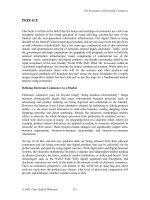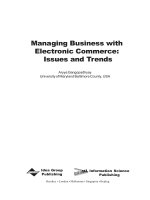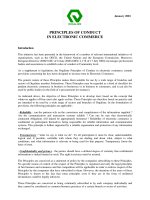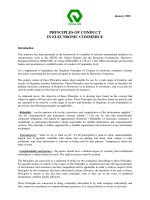Electronic commerce fundamentals ch4
Bạn đang xem bản rút gọn của tài liệu. Xem và tải ngay bản đầy đủ của tài liệu tại đây (983.81 KB, 38 trang )
Chapter 4
4
Electronic Commerce
Software
Electronic Commerce
1
Objectives
Desirable functions of E-commerce
software and ISP-hosted solutions
◆ Types of traditional and electronic
stores
◆ Software packages for small, medium,
and large e-commerce sites
◆ Characteristics of several electronic
commerce sites
◆
4
2
What kind of software solution is
necessary for your needs?
Range of pricing options, from almost
nothing to more than $100,000
◆ Factors that determine E-commerce
software needs:
◆
4
●
●
●
●
Enterprise size and projected traffic & sales
Budget
Target commerce audience
Technical ability, training, and equipment
3
E-commerce Requirements
◆
4
All e-commerce solutions must provide
at minimum:
●
●
●
●
A catalog display
Shopping cart capabilities
Transaction processing
Tools to modify and add to the store catalog and
storefront display
4
Catalog Display
◆
4
Definition: a static listing of goods and
services
● Small
storefronts (less than 35 items) can
have minimum navigation and organization
● Large storefronts must categorize items,
and provide several methods of finding
items (i.e. search engines)
● Rule: Never stand in the way of a
customer who wants to purchase!
5
Large Electronic Commerce Site
Figure 4-1
4
6
Small Electronic Commerce Site
Figure 4-2
4
7
Shopping cart
◆
4
Represents an improvement over
forms-based shopping
●
●
◆
Forms were awkward and time-intensive
Not user-friendly, confusing and error-prone
Shopping carts
●
●
●
●
Keeps track of items selected
Items can be added or removed
All item identification is stored automatically
Running totals are kept
8
Using a Form to Enter an Order
Figure 4-3
4
9
How Shopping Carts Work
◆
4
The Web is a stateless system- unable
to remember from one transmission to
another
●
Therefore, shopping carts must store information
about each shopping cart, to avoid mixed-up
purchases. Methods used include:
◆ Cookies- stored information on a shopper’s
hard drive
◆ Temporary numbers added to the end of a
shopper’s URL
10
Transaction Processing
Mechanism
Required when the shopper clicks the
checkout button
◆ Usually, browser changes to Secure
Sockets Layer (SSL)
◆ Software calculates tax, shipping
charges, discounts
◆
4
●
●
Some software packages connect directly with
shippers to get shipping costs
Connected with seller’s internal accounting system
to allow tallying of Web sales
11
An Electronic Commerce Shopping Cart
Figure 4-4
4
12
E-commerce Tools
◆
Inexpensive hosted e-commerce solutions
●
●
4
◆
Can create a storefront in less than 1 hour
Fees vary, but some allow online business for a few
hundred dollars a month; one-time setup fees can be
up to $200
◆ All charge monthly fee based on number of items
for sale
Mid-range systems
●
●
Prices range from $1000 to over $5000
Connect into database servers, but are not included
in the commerce server price
13
E-commerce Tools
◆
Large business solutions
● Business-to-consumer
4
transactions
● Business-to-business transactions require
additional tools:
Encryption
◆ Authentication
◆ Digital signatures and signed receipt notices
◆ Ability to connect to existing legacy systems
including Enterprise Resource Planning (ERP)
software
◆
14
Business-to-Business
Commerce Server Topology
Figure 4-5
4
15
Marketing Smarts
◆
4
Critical to obtain visibility to get traffic to
your site
Web malls will list your site in a portal-style
directory
● Least expensive method for getting visibility
is obtaining and registering your own
domain name
●
◆
Make the name say something about your
business
● Use
Meta tags and search engines
16
Hosting Services
◆
4
Good for businesses unprepared to
obtain all the hardware and software
necessary for a Web presence
● Advantages
Spreads costs of a large website over several
“renters”
◆ Host provides all expertise, registration,
payment processing, shipping, and taxes
◆ Lowers costs because other “tenants” share
hardware and software infrastructure
◆
17
Basic Packages
◆
Fundamental host services
● Free
4
or low-cost for small businesses (less
than 50 products and low order volume)
● Do not include shopping carts or
transaction processing
● Host makes money by placing advertising
banners on storefronts
● Provide templates for constructing a
commerce site, although unsophisticated
18
BizLand.com’s Hosting Service
Figure 4-6
4
19
Banner Advertising
Exchange Sites
Help electronic merchants promote
their stores online
◆ Banners are mutually exchanged
instead of selling advertising space
◆ Provide ad monitoring software to help
determine their advertising clickthrough count
◆ Provide helpful articles on a variety of
advertising topics
◆
4
20
LinkExchange
Figure 4-7
4
21
Full-Service Mall-Style Hosting
Offers online stores good service, good
Web creation tools, and no banner
advertising clutter
◆ Charges a higher monthly fee than
basic service providers
◆ Provides shopping cart software
◆ Comprehensive customer transaction
processing, including credit card
acceptance
◆
4
22
Successful Store Builders and
Hosting Services
◆
Yahoo!Store
● Monthly
4
fees that vary between $100 -
$700
● Provides store fronts for very small
businesses, as well as The Shaper Image
and Rolling Stone
● Web-based editing of storefronts
23
Editing a Yahoo!Store Storefront Page
Figure 4-8
4
24
An Item’s Order Page
Figure 4-9
4
25









